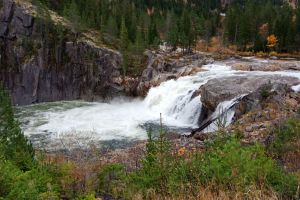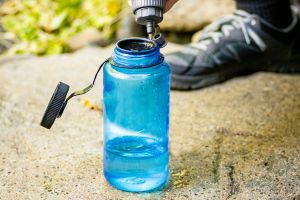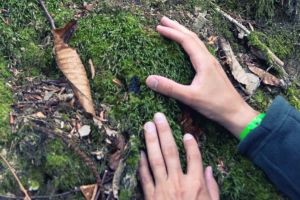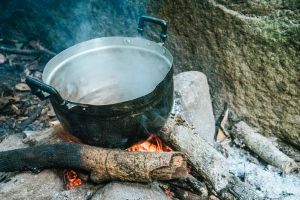[ad_1]
It’s uncommon to search out water within the wild which is secure to drink. Naturally occurring water will both be muddy, comprise floating particles (together with small particles), or have microscopic pathogens in it. Lengthy gone is the day once we might safely drink water from a transparent working stream or spring.
In a survival scenario, we now have to imagine that any water we discover is unsafe to drink, irrespective of how clear and clear it’d look (assuming you’ll be able to really discover clear water). Even water that tastes good may not be secure to drink.
That’s why its finest to hold some form of water filter with you, at any time when you might be within the wild. Most individuals use a straw-type water filter, such because the Lifestraw for day journeys, survival kits and bug out baggage.
For an extended time period, similar to a tenting journey, you’ll want one thing that may deal with a bigger quantity of water, similar to one of many bag-type filter methods, which take water from one bag, via a filter and into one other bag. Lifestraw makes a superb considered one of these and so does Sawyer.
However what if you end up within the wild, with none of these water filters? It’s a must to make it possible for your water is secure to drink, in any other case there’s an opportunity of getting dysentery, which may kill.
⇒ 10 Medical Provides You Must Stockpile Earlier than It’s too Late
Truly, we have to concern ourselves with each filtration and purification. Whereas usually used interchangeably, these two phrases don’t imply the identical factor. Filtration removes any suspended sediment within the water, similar to dust, sand or natural matter.
Purification kills or removes microscopic pathogens. Of the 2, the microscopic pathogens are the extra harmful, however the sediment will have an effect on the style of the water and the way appetizing it’s to drink. I don’t find out about you, however I’m not an actual fan of consuming muddy water.
For the sake of creating water secure to drink, we might have to make use of each filtration and purification strategies. Some filters, like those I discussed above, filter water so nicely, that additionally they handle to purify it, eradicating the microscopic pathogens. However until you might have a water filter that advertises that it removes 99.99% of micro organism, I wouldn’t rely it to purify your water.
Water Filtration within the Wild
 Assuming that you just don’t have one of many water filtration methods talked about above, you’re going to have to make use of what nature supplies to filter your water.
Assuming that you just don’t have one of many water filtration methods talked about above, you’re going to have to make use of what nature supplies to filter your water.
Whereas these strategies might not filter the water in addition to the filters talked about above, they may make it drinkable.
You possibly can study extra about water filtration within the wild on this information. Right here additionally, you will discover out 4 extra water filtration and purification strategies, together with important information on crafting numerous forms of hearth for survival, setting up wilderness shelters, and different invaluable data for surviving long-term within the wild throughout a disaster.
One factor to remember with any filter, is that the extra sediment that’s within the water, the quicker the filter will clog. This implies both changing the filter or cleansing the filter medium. For the strategies we’re going to speak about, cleansing is an actual chance, particularly when you have a plentiful water supply, like a stream to make use of.
Let it Sit
The best technique of eradicating sediment from water is to simply let the water sit. Napoleon Bonaparte is quoted as saying, “Soiled water, left sitting in a single day, turns into clear.”
A lot of the sediment that’s present in water will settle out of the water, if the water is positioned in a container and allowed to sit down in a single day, because the sediment is usually heavier than the water. Rigorously scooping out something floating on the floor after which pouring off the water, after the sediment settles, will present water that’s comparatively clear.
Sand and/or Charcoal
 The “Bio-filter” is a standard method utilized in survival and third-world international locations.
The “Bio-filter” is a standard method utilized in survival and third-world international locations.
It consists of a three-layer filter, utilizing gravel, sand and eventually activated charcoal. Every of the three filter mediums removes progressively smaller sediment, to the purpose of the activated charcoal, which can take away virtually the entire micro organism.
Associated: 8 Myths About Storing Water That Are Truly True
Some individuals add extra layers of sand and gravel, after the activated charcoal, however they aren’t mandatory, until it’s to maintain the activated charcoal from popping out of the filter.
The issue with this, from a survival viewpoint, is that this can be very tough to make activated charcoal within the wild, as that requires chemical compounds that we’re unlikely to have with us. Nonetheless, sand and/or crushed charcoal will work to take away most virtually all sediment and enhance the style of the water, by eradicating impurities. It simply received’t take away the microscopic pathogens.
Fabric
Fabric, particularly any tightly-woven material, works nicely to filter sediment out of water. If the fabric doesn’t appear to be doing nicely sufficient, merely double the fabric over, in order that the water has to cross via a number of layers. Every layer will seize and take away extra sediment.
Moss
 One other naturally occurring materials for making filters is moss, assuming you’re in an space the place it may be discovered.
One other naturally occurring materials for making filters is moss, assuming you’re in an space the place it may be discovered.
Each stay and dry moss can be utilized equally nicely.
The dry moss will swell because it absorbs water, making for finer filtration.
To be able to do that, you’ll want a discarded soda bottle; one thing that’s often straightforward to search out. Minimize off the underside of the soda bottle to make a funnel. Then flip the funnel slim aspect down and pack the funnel as full as you’ll be able to with moss. As soon as the moss swells from the water, it should filter slowly; however will probably be fairly efficient.
Associated: The Most Widespread Edible Bushes Rising in Your State
This form of filter doesn’t lend itself to reusing the filter medium, because the moss tends to interrupt up whenever you try to clear it. So, you’ll have to make sure that you retain searching for extra moss to refresh your filter with, as wanted.
Purifying Water within the Wild
Since filtering water doesn’t assure that it will likely be secure to drink, we are able to’t actually speak about filtration, with out speaking about purification as nicely. The most typical strategies of purifying water are a mixture of filtration and chemical remedy.
However should you don’t occur to have chlorine or iodine with you, the chemical remedy is out of query. That leaves us to different strategies. Please notice that you just’ll wish to use these strategies after you’ve already eliminated the sediment with a filter.
Boiling
Maybe the oldest and most generally identified technique of water purification is using warmth. Just about everybody is aware of you could purify water by boiling it. However few individuals know that you just don’t actually need to get the water scorching sufficient to boil, to have the identical impact.
Water boils at a temperature of 212°F, however the water solely has to achieve 158°F to kill micro organism, protozoa and viruses. Elevating water (or another liquid) to this temperature to purify it is named “pasteurization.” Using pasteurization, relatively than boiling, saves on gasoline, which might be vital in some survival conditions.
 Some form of heat-resistant container is required to boil or pasteurize water. As well as, a way of measuring the water’s temperature is required for pasteurization.
Some form of heat-resistant container is required to boil or pasteurize water. As well as, a way of measuring the water’s temperature is required for pasteurization.
This generally is a thermometer or a WAPI (water pasteurization indicator), which is good for placing in a survival equipment or bug out bag.
The WAPI consists of a plastic capsule with a wax pellet inside. The wax is formulated to soften at 160°F, indicating that the water is scorching sufficient to be pasteurized. As soon as the WAPI is faraway from the new water and allowed to chill, the wax solidifies, permitting the WAPI for use once more.
Distillation
After we boil water, some portion of that water coverts to water vapor or steam, evaporating. That water vapor might be captured and allowed to chill, condensing again to water. When that occurs, you get extraordinarily pure water, as the whole lot however the water will get left behind.
The concept is to make what is usually known as a “photo voltaic nonetheless.” This consists of a bit of plastic sheeting, suspended over a gap which accommodates the water supply.
A small stone is positioned on the sheeting, making a dip level for the distilled water to drip off of and into one other container. The higher the plastic sheeting is sealed to the bottom, the extra effectively the system will work.
Ultraviolet Mild
 A a lot less complicated approach of purifying water is to make use of ultraviolet gentle (UV gentle). That is frequent in these roadside water locations, the place you’ll be able to fill your individual containers with purified water. They use UV gentle as a result of it should kill viruses, whereas viruses are so small, that it’s tough to take away them with filtration. UV gentle additionally kills micro organism and protozoa.
A a lot less complicated approach of purifying water is to make use of ultraviolet gentle (UV gentle). That is frequent in these roadside water locations, the place you’ll be able to fill your individual containers with purified water. They use UV gentle as a result of it should kill viruses, whereas viruses are so small, that it’s tough to take away them with filtration. UV gentle additionally kills micro organism and protozoa.
We’ve got an plentiful supply of UV gentle hanging over our heads daily, within the solar. So long as we now have good daylight, we now have enough UV to purify water.
All we now have to do is pour the water right into a shallow container and set it within the daylight, making certain that there isn’t a shadow. UV will kill microscopic pathogens in 10 seconds; however simply to make sure, go away it for a few minutes.
Alcohol
Moreover warmth, alcohol might be the oldest technique of water purification. Wine was added to the native water in lots of historic cultures, with the intention to make it secure to drink. The alcohol naturally kills the micro organism, making the water secure to drink. That is the foundation of why we discover individuals in some international locations consuming wine with each meal.
The quantity of wine required for water purification is one thing extensively disputed. House’s Odyssey states one a part of water to twenty components of wine, giving us some perception into the traditional Greek and Roman cultures.
Nonetheless, the traditional Jewish tradition, amongst others, used one half wine to 4 components water. If stronger alcoholic drinks are used, the quantity of alcohol might be minimize.
Wine is usually 12% alcohol, the place as onerous liquor is usually 40% alcohol, so a bit lower than 1/3 could be wanted. Please notice that this needs to be consuming alcohol, not rubbing alcohol.
[ad_2]
Source link




